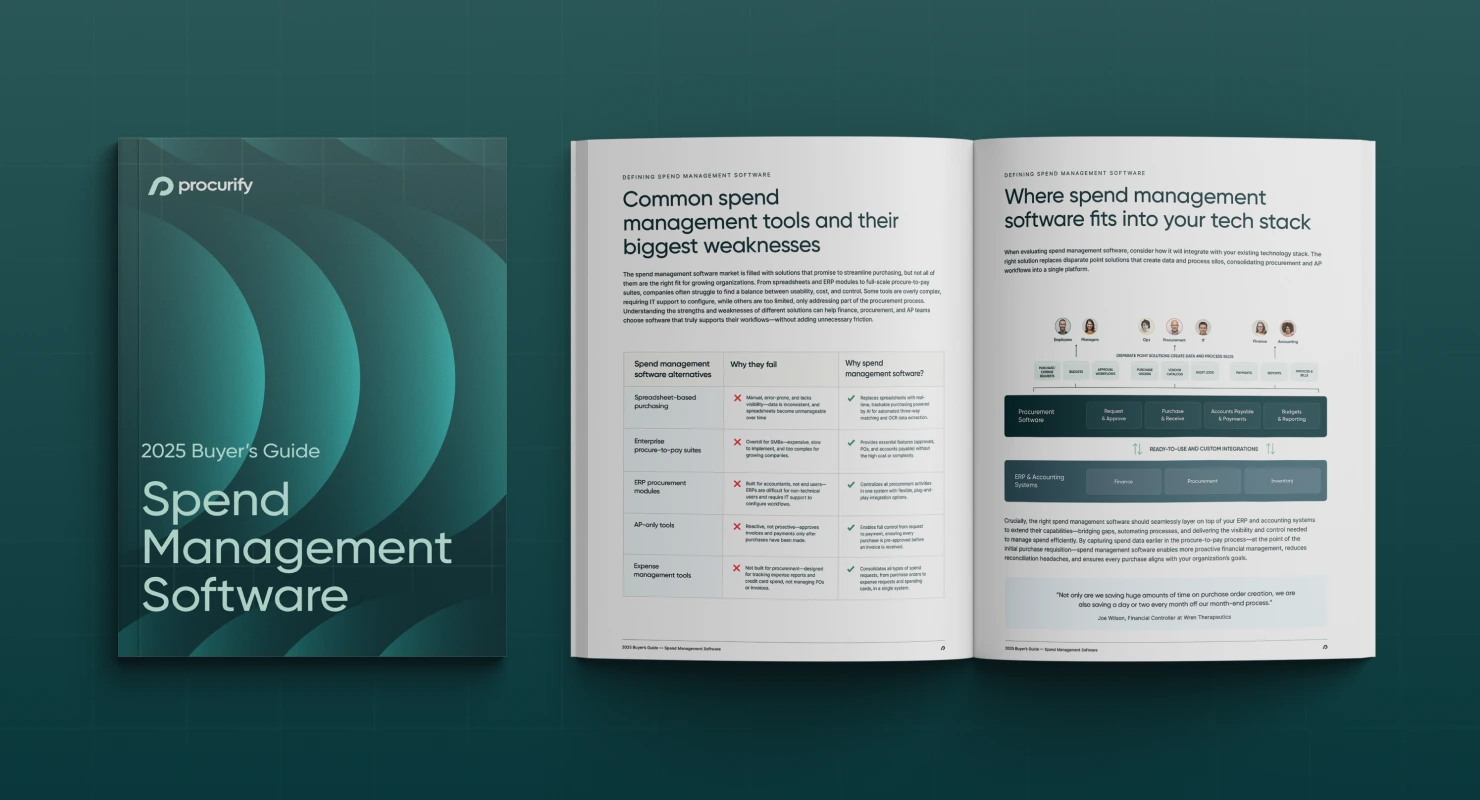6 Procurement Trends to Watch for in 2021
According to The World Bank, the COVID-19 pandemic plunged most countries into recession in 2020. And although the global economy is growing again after a 4.2 percent contraction, many things remain uncertain.
There’s no arguing that the impact COVID-19 has had on procurement is massive. In 2020 alone, companies had to adapt by cutting costs and reducing budgets, and many financial leaders went searching for a quick solution to controlling spend in a distributed workplace.
But while short-term solutioning was essential in 2020, putting a bandaid on a bullet wound doesn’t stop the bleeding.
In 2021, then, procurement leaders must begin implementing strategies and processes that address long-term change and that help businesses successfully adapt to this ‘new’ normal.
At Procurify, we recently invited a panel of respected procurement experts to shed light on this topic. In the podcast, they share strategies and practical tips for accomplishing long-term change during this unprecedented time.
Here are six key procurement trends to watch for in 2021 that we identified from the conversation.
Who did we speak to?
We were lucky enough to speak with some of the most talented procurement leaders out there, including:

Richard Struthers, Managing Partner at Consultancy 21
Richard has an extensive background in procurement consulting, interim and client-based roles. He has an excellent track record of inspiring and leading teams covering various procurement categories to deliver strategic projects and financial savings across direct and indirect spend portfolios.

James Meads, Procurement Consultant and Host of the Procuretech Podcast
James Meads has over 17 years of procurement experience in large manufacturing companies in three different countries. He helps them reduce what they’re spending with external suppliers and achieve more with less.

Phil Ha, Customer Success Manager at Procurify
Phil has excellent relationships with customers from 30+ countries around the world. He is a champion and advocate for customers of Procurify and works closely with the product team.
Trend #1: Do more with less in 2021
The economic downturn in 2020 forced many businesses to scale back their resources, and consequently, many departments lost good team members. (They also lost access to some essential digital tools that make work easier.)
Since these resources are unlikely to be replaced in the short term, organizations must adjust and find ways to do more with less, while continuing to meet strategic objectives.
In procurement, there’s a shift towards hiring interim leaders and contractors to fill resource gaps. And in many cases, individuals within procurement operations are responsible for tackling strategic initiatives for which they haven’t been adequately trained.
As explained by James Meads on the podcast: “It’s really about taking a step back and thinking: how can we get more out of our existing resources by working smarter, not necessarily harder?”
To do this, procurement leaders can invest in training and development that enables better time management (including remote communication) , which in turn helps to set teams up for success.
What’s more, teams will have to re-introduce some essential systems that eliminate manual or administrative tasks and focus on optimizing spend by streamlining operations. This way, teams can gain valuable time back to focus on growth rather than process development.
Trend #2: Spend optimization is at the forefront in 2021
If we learned anything last year, it’s that everything we do is unknown and uncertain, and the only way to survive this is by optimizing spend to generate positive cash flow.
Therefore, things like spend visibility, proactive control over who spends what (and when), and efficient procurement processes are imperative. To reach this place in a distributed workforce, however, is no easy feat, and finance and operations teams need a centralized ‘all under one roof’ procurement tool that offers both calm and clarity.
In a downturn economy, finding calm and clarity becomes even harder. It requires a solid foundation to build from, and it calls for strategic leadership decisions that consider all possibilities.
To build this foundation, procurement leaders should look at three key areas:
1. The age of the organization
The age of an organization is critical to determine procurement needs. On the one hand, a young company might not have any processes for procurement and will likely face challenges such as maverick spending leading to cash flow issues.
A mature organization, however, might struggle to retain clarity or governance on spending due to rapid growth. They might also face the challenge of modernizing from legacy systems.
In both instances, young or old, it’s difficult to implement one efficient and standardized way to do something.
2. Understanding around data and process
A stable data collection and analysis process is imperative to effective spend management. Having a procurement process makes it possible to collect good quality data that makes overseeing contracts and vendor management easier. It also sets a company up for SOX compliance when it’s ready to go public.
3. Contract management
With a reliable procurement process in place, a company can achieve a level of visibility that can improve contract management. Fundamentally, this includes understanding when contracts will end so they can go to tender or be renegotiated.
More than that, though, strategically managing contracts allows procurement professionals to evaluate supplier performance and find opportunities to negotiate savings or more favourable terms. Quite simply, effective contract management makes it possible to optimize spending by realizing savings and protecting supply.
Trend #3: SMBs, focus on designing an effective procurement strategy
Start-ups and small to medium businesses (SMBs) have a number of unique opportunities to optimize spend. Oftentimes, smaller companies like these have a blank canvas; they lack any type of procurement strategy and can therefore work from the ground up.
For those that have a workable foundation in place, it’s important to begin optimizing spend and improving operational efficiency as soon as possible. James Meads recommends implementing basic policies and processes in the short term, but doing so sensibly. As he explains on the podcast, “You’ve got to balance control over flexibility.”
Balancing control and flexibility in procurement
To do this, start taking control of maverick spend by introducing basic spend policies. By doing this, companies can begin patching cash flow leaks and regain control of rogue spending.
An open payment policy, for example, gives SMBs the chance to introduce basic ‘rules for spending’, while remaining flexible enough to ensure organizational buy-in. Another way to regain control is to ensure purchase orders are accurate to give the company clarity over purchases and expenses.
Beyond this, an SMB should consider hiring an experienced interim procurement leader to create policies and processes for the longer term. When selecting the right person, our experts recommend looking for a professional with relevant experience in the industry and a good track record with similar initiatives. As Richard Struthers explains:
“Are they going to be a right cultural fit? And how are they going to do all the influencing that needs to be done?”
These considerations help to empower a procurement leader so they can create policies and processes that align with the way the company operates now and in the future.
Trend #4: Streamline, streamline, streamline
As foundations are put in place and a procurement process emerges, it’s natural for problems to present themself. Time, for example, is often dedicated to process development rather than optimizing spend.
But, by focusing on streamlining the procurement process in 2021, companies can begin to eliminate common time wasters, including:
Day-to-day firefighting
Broken processes frequently put procurement teams in the position of putting out flames rather than building houses. For example, procurement professionals often lose time answering vendor questions, dealing with late payments, and mitigating delivery issues.
With an effective procure-to-pay process in place, however, companies can reduce the frequency of fires and instead focus on tiling the roof (we’re sorry, this metaphor got away from us…).
We’ll let James Mead explain this one:
“We provide a service to other parts of the business, and consequently, we constantly deal with issues rather than strategy. This severely impedes our ability to do our job properly.”
Dealing with unnecessary bureaucracy
Complicated procurement processes lead to unnecessary bureaucracy. “Make it easy and make it simple,” explains James on the podcast. “Taking processes out rather than putting processes in is usually the best way.”
To do this, find ways to empower purchasers and simplify approvals. Companies should aim to introduce software solutions that make it possible to approve purchases with the click of a button and from the convenience of a mobile app. What’s more, these tools should be self-service to reduce red tape and make procurement more efficient.
Without these time wasters, procurement professionals can spend more time on strategic procurement initiatives instead.
Trend #5: Procurement and finance teams must work together in 2021
One of the key ways that finance and procurement can drive growth is to partner together. Together, these departments can agree on budgets, determine benchmarks to measure real-time budget progress, and implement cost-effective strategies to improve processes.
As Richard says, “I think what really, really works is when procurement provides a savings plan to finance teams and gives clarity on how to achieve targets.” By doing this, the procurement team becomes a strategic partner, driving business growth, and organizational change.
Making finance and procurement work together
To make this partnership successful, however, procurement and finance need to understand each other’s strategic functions. Procurement, for example, should aim to understand the way finance reports (like profit and loss sheets and balance statements) impact the business. With this knowledge, procurement leaders can begin to implement departmental change that impacts the bottom line. As Richard explains:
“How is it that procurement can help to maximize budgets by implementing better control on costs, but also negotiate better deals with suppliers? It comes down to a two-way sharing of information between the two functions.”
By the same token, finance teams need to understand the value procurement provides. After all, procurement teams often:
- Negotiate on cost
- Implement price avoidance initiatives
- Factor in capital expenditure
- Set rigid spending budgets for departments
To do this, teams must avoid data siloing and work from under one roof. In short, finance needs to see how procurement manages spending, and vice versa. Only then can both teams have calm and clarity over spending.
Trend #6: Use technology to save on time and money
The final piece of the puzzle is to implement a cost-effective tool that gives teams control over spending.
To do this, procurement leaders need to understand and address short-term procurement challenges, and establish some key strategic initiatives that will drive change. Consider things like:
- Overcoming the challenge of controlling spend
- Building cross-departmental visibility into spending
- Centralizing and streamline purchasing processes
As James explains on the podcast, “If you know what your biggest problem or challenge is, if you know what you want to solve, then in the words of the great philosopher, Jon Bon Jovi, you’re halfway there.”
With this level of understanding in place, you can make an informed decision on the systems you need. From here, it’s time to work with your IT team to introduce this technology and modernize your processes.
When this is done, it’s time for continuous optimization, testing and experimenting to iron out the inevitable creases. For example:
- Build training so teams know how the procurement process works.
- Make life easier for everyone by introducing a mobile app.
- Deliver a spend policy that works with the technology you choose.
- Reinforce specific rules or ways of working across the company, like a spend culture
- Fundamentally, make things as simple as possible.
Simplicity is key here. A good user experience and efficient processes will help drive adoption and ensure that change lasts for good.
For a comprehensive guide to finding the right procurement solution, we created a 14-step checklist.
Here’s the bottom line
With challenge comes opportunity. Sure, 2020 was a tough year, and it’s certainly important to take stock and recognize that you’re having to do more with less in 2021. But that doesn’t have to stifle your opportunity to grow.
With strong foundations, efficient processes, strategic partnerships, and the right technology, teams can deploy long-term solutions that not only stabilize a business’s bottom line, but that also offer innovation, growth, and an opportunity to regain control on spending. As explained by Procurify’s CEO, Aman Mann, in our report The Future of the CFO:
“Change is inevitable. Change must not be viewed as a threat, but rather as an opportunity. CFOs who succeed in the coming months and years will be those who are able to adapt and continue innovating. Every scary and difficult challenge builds us up. As we take more risks and go through more failures, we become more powerful and less afraid, because we know what it’s like to fail. That’s what real growth is.”

2025 Spend Management Software Buyer’s Guide
Choose the spend management solution best suited to your organization’s needs with an overview of the 2025 software ecosystem, feature comparisons, and a free vendor capability evaluation checklist.
